Compression Behavior of Concrete Columns Strengthened with Fiber-Reinforced Inorganic Composites Based on Magnesium Phosphate Cement
Abstract
:1. Introduction
2. Experimental Program
2.1. Raw Materials
2.2. Testing Specimens
2.3. Specimen Preparation
2.4. Material Properties
2.5. Instrumentation and Testing Setup
3. Test Results and Discussion
3.1. Failure Mode
3.2. Flat-Coupon Tensile Tests
3.3. Stress–Strain Behavior
3.4. Ultimate Condition
3.5. Hoop Rupture Strain
3.6. Strain Localization
3.6.1. Strain Development on Surface of Specimens
3.6.2. Strain Development along Specimen Height
3.6.3. Strain Development around Specimen Perimeter
4. Theoretical Models
4.1. Overview
4.2. Simple Model to Predict Axial Strength and Axial Strain
5. Conclusions
- Similar to the FRP-confined specimens, all the FRiP-confined columns failed due to FRP fracture, and no debonding failure occurred. With an increase in the FRP layers, the failure mode of the FRiP-confined specimens changed from progressive failure to sudden failure.
- The CFRiP system based on magnesium phosphate cement had the same linear elastic constitutive law as the FRP system but exhibited lower tensile strength and strain.
- The CFRiP system based on magnesium phosphate cement significantly improved the strength and ductility of the concrete columns. The FRiP-confining system had the same effect as the FRP-confining system on improving the strength of the concrete columns; however, the ultimate strain of the FRiP-confined columns was only 60% of that of the FRP-confined specimens.
- The strain efficiency factor of the CFRiP system based on magnesium phosphate cement was 0.33, much lower than that of the FRP system.
- The DIC results showed that the FRiP- and FRP-confined columns had a similar Von Mises strain evolution law. The uniformity of the strain distribution of the specimens improved as the confinement stiffness increased, proving that the stress distribution was more uniform in thicker FRP jackets, and the failure mode of the FRiP-confined columns was closer to that of the FRP-confined specimens.
- A semiempirical model for predicting the ultimate axial strength and ultimate axial strain of concrete columns confined by the CFRiP system based on magnesium phosphate cement was proposed based on the experimental results. The proposed model was based on limited experimental results, so further studies are required to improve and verify it.
Author Contributions
Funding
Institutional Review Board Statement
Informed Consent Statement
Data Availability Statement
Conflicts of Interest
References
- Farzampour, A. Compressive behavior of concrete under environmental effects. Compressive Strength Concr. 2019, 92–104. [Google Scholar]
- Farzampour, A. Temperature and humidity effects on behavior of grouts. Adv. Concr. Constr. 2017, 5, 659. [Google Scholar] [CrossRef]
- Chalangaran, N.; Farzampour, A.; Paslar, N.; Fatemi, H. Experimental investigation of sound transmission loss in concrete containing recycled rubber crumbs. Adv. Concr. Constr. 2021, 11, 447–454. [Google Scholar] [CrossRef]
- Chalangaran, N.; Farzampour, A.; Paslar, N. Nano silica and metakaolin effects on the behavior of concrete containing rubber crumbs. Civ. Eng. 2020, 1, 264–274. [Google Scholar] [CrossRef]
- Naser, M.Z.; Hawileh, R.A.; Abdalla, J.A. Fiber-reinforced polymer composites in strengthening reinforced concrete structures: A critical review. Eng. Struct. 2019, 198, 109542. [Google Scholar] [CrossRef]
- Siddika, A.; Al Mamun, M.A.; Ferdous, W.; Alyousef, R. Performances, challenges and opportunities in strengthening reinforced concrete structures by using FRPs—A state-of-the-art review. Eng. Fail. Anal. 2020, 111, 104480. [Google Scholar] [CrossRef]
- Bai, Y.L.; Dai, J.G.; Teng, J.G. Buckling of steel reinforcing bars in FRP-confined RC columns: An experimental study. Constr. Build. Mater. 2017, 140, 403–415. [Google Scholar] [CrossRef]
- Eid, R.; Paultre, P. Compressive behavior of FRP-confined reinforced concrete columns. Eng. Struct. 2017, 132, 518–530. [Google Scholar] [CrossRef]
- Guler, S.; Ashour, A. Review of current design guidelines for circular FRP-wrapped plain concrete cylinders. J. Compos. Constr. 2016, 20, 04015057. [Google Scholar] [CrossRef]
- Lin, G.; Teng, J.G. Three-dimensional finite-element analysis of FRP-confined circular concrete columns under eccentric loading. J. Compos. Constr. 2017, 21, 04017003. [Google Scholar] [CrossRef]
- Ouyang, L.J.; Gao, W.Y.; Zhen, B.; Lu, Z.D. Seismic retrofit of square reinforced concrete columns using basalt and carbon fiber-reinforced polymer sheets: A comparative study. Compos. Struct. 2017, 162, 294–307. [Google Scholar] [CrossRef]
- Gharachorlou, A.; Ramezanianpour, A.A. Resistance of concrete specimens strengthened with FRP sheets to the penetration of chloride ions. Arab. J. Sci. Eng. 2010, 35, 141–154. [Google Scholar]
- Liu, S.; Yang, Z.; Zhang, J.; Zhao, J.C. Study on bond-slip degradation model of CFRP and concrete interface under sulfate erosion environment. Compos. Struct. 2021, 267, 113877. [Google Scholar] [CrossRef]
- Zhou, Y.W.; Xing, F.; Sui, L.L. Refinement of an ultimate strain model for circular concrete columns retrofitted with FRP based on a most comprehensive test database. Appl. Mech. Mater. 2013, 275, 1233–1238. [Google Scholar]
- Galati, N.; Vollintine, B.; Nanni, A.; Dharani, L.R.; Aiello, M.A. Aiello Thermal effects on bond between FRP rebars and concrete. Compos. Part A 2006, 37, 1223–1230. [Google Scholar] [CrossRef]
- Katz, A.; Berman, N.; Bank, L.C. Effect of high temperature on bond strength of FRP rebars. J. Compos. Constr. 1999, 3, 73–81. [Google Scholar] [CrossRef]
- Ombres, L. Concrete confinement with a cement-based high-strength composite material. Compos. Struct. 2014, 109, 294–304. [Google Scholar] [CrossRef]
- Zhang, J.; Li, H.; Liu, S.; Zhang, X.Y.; Yang, C.H.; Zhang, R.L. Bond behavior of the CFRP-concrete interface under combined sustained load and sulfate erosion. Structures 2022, 35, 551–564. [Google Scholar] [CrossRef]
- Lu, Z.; Xie, J.; Zhang, H.; Li, J.L. Long-term durability of basalt fiber-reinforced polymer (BFRP) sheets and the epoxy resin matrix under a wet–dry cyclic condition in a chloride-containing environment. Polymers 2017, 9, 652. [Google Scholar] [CrossRef]
- Yamazaki, D.; Iwanami, M.; Isa, M. Assessment of Outdoor Exposure Effects on the Long-term Durability of Epoxy Resin Adhesives Used for Steel-plate Bonding. J. Adv. Concr. Technol. 2020, 18, 463–472. [Google Scholar] [CrossRef]
- Jiang, F.; Yang, Q.; Wang, Y.; Wang, P.; Hou, D.S.; Jin, Z.Q. Insights on the adhesive properties and debonding mechanism of CFRP/concrete interface under sulfate environment: From experiments to molecular dynamics. Constr. Build. Mater. 2021, 269, 121247. [Google Scholar] [CrossRef]
- Frigione, M.; Lettieri, M. Durability issues and challenges for material advancements in FRP employed in the construction industry. Polymers 2018, 10, 247. [Google Scholar] [CrossRef] [PubMed]
- Ascione, F.; Granata, L.; Guadagno, L.; Naddeo, C. Hygrothermal durability of epoxy adhesives used in civil structural applications. Compos. Struct. 2021, 265, 113591. [Google Scholar] [CrossRef]
- Qiao, P.; Xu, Y. Effects of Freeze-Thaw and Dry-Wet Conditionings on the Mode-I Fracture of FRP-Concrete Interface Bonds. Earth Space 2004, 601–605. [Google Scholar]
- Awani, O.; El-Maaddawy, T.; Ismail, N. Fabric-reinforced cementitious matrix: A promising strengthening technique for concrete structures. Constr. Build. Mater. 2017, 132, 94–111. [Google Scholar] [CrossRef]
- Guo, L.; Deng, M.; Chen, H.; Li, R.; Ma, X.; Zhang, Y. Experimental study on pre-damaged RC beams shear-strengthened with textile-reinforced mortar (TRM). Eng. Struct. 2022, 256, 113956. [Google Scholar] [CrossRef]
- Cascardi, A.; Longo, F.; Micelli, F.; Aiello, M.A. Compressive strength of confined column with Fiber Reinforced Mortar (FRM): New design-oriented-models. Constr. Build. Mater. 2017, 156, 387–401. [Google Scholar] [CrossRef]
- Bhuvaneshwari, P.; Mohan, K.S.R.; Kirthiga, R. Stress strain behaviour of concrete element retrofitted using organic and inorganic binders. Asian J. Appl. Sci 2014, 7, 215–223. [Google Scholar] [CrossRef]
- Shiping, Y.; Boxue, W.; Chenxue, Z.; Shuang, L. Bond performance between textile reinforced concrete (TRC) and brick masonry under conventional environment. Structures 2022, 36, 392–403. [Google Scholar] [CrossRef]
- Dai, J.G.; Munir, S.; Ding, Z. Comparative study of different cement-based inorganic pastes towards the development of FRIP strengthening technology. J. Compos. Constr. 2014, 18, A4013011. [Google Scholar] [CrossRef]
- American Concrete Institute (ACI). Guide to Design and Construction of Externally Bonded Fabric-Reinforced Cementitious Matrix (FRCM) Systems for Repair and Strengthening Concrete and Masonry Structures; ACI 549.4 R-13; ACI Committee: Farmington Hills, MI, USA, 2013; p. 549. [Google Scholar]
- International Code Council (ICC). Acceptance Criteria for Masonry and Concrete Strengthening Using Fabric-Reinforced Cementitious Matrix (Frcm) Composite Systems; AC434-13; ICC Evaluation Service: Whittler, CA, USA, 2013. [Google Scholar]
- Zhang, H.; Hao, X.; Fan, W. Experimental study on high-temperature properties of carbon fiber sheets strengthened concrete cylinders using geopolymer as adhesive. Procedia Eng. 2016, 135, 47–55. [Google Scholar] [CrossRef]
- Dai, J.; Munir, S.; Ding, Z. Mix design of inorganic pastes as matrices and bonding adhesives of fiber sheets for strengthening of existing concrete structures. In Proceedings of the International Conference on Concrete Sustainability, Tokyo, Japan, 1 January 2013. [Google Scholar]
- Ding, Z.; Dai, J.G.; Muner, S. Study on an improved phosphate cement binder for the development of fiber-reinforced inorganic polymer composites. Polymers 2014, 6, 2819–2831. [Google Scholar] [CrossRef]
- Napoli, A.; Realfonzo, R. Compressive strength of concrete confined with fabric reinforced cementitious matrix (FRCM): Analytical models. Compos. Part C Open Access 2020, 2, 100032. [Google Scholar] [CrossRef]
- Xue, X.; Liu, Y.L.; Dai, J.G.; Poon, C.S.; Zhang, W.D.; Zhang, P. Inhibiting efflorescence formation on fly ash–based geopolymer via silane surface modification. Cem. Concr. Compos. 2018, 94, 43–52. [Google Scholar] [CrossRef]
- He, P.; Poon, C.S.; Tsang, D.C.W. Comparison of glass powder and pulverized fuel ash for improving the water resistance of magnesium oxychloride cement. Cem. Concr. Compos. 2018, 86, 98–109. [Google Scholar] [CrossRef]
- Qiao, F.; Chau, C.K.; Li, Z. Property evaluation of magnesium phosphate cement mortar as patch repair material. Constr. Build. Mater. 2010, 24, 695–700. [Google Scholar] [CrossRef]
- Li, Y.; Bai, W.; Shi, T. A study of the bonding performance of magnesium phosphate cement on mortar and concrete. Constr. Build. Mater. 2017, 142, 459–468. [Google Scholar] [CrossRef]
- Ding, Z.; Xu, M.R.; Dai, J.G.; Dong, B.Q.; Zhang, M.J.; Hong, S.X.; Xing, F. Strengthening concrete using phosphate cement-based fiber-reinforced inorganic composites for improved fire resistance. Constr. Build. Mater. 2019, 212, 755–764. [Google Scholar] [CrossRef]
- Du, Y.; Gao, P.; Yang, J.; Shi, F. Research on the chloride ion penetration resistance of magnesium phosphate cement (MPC) material as coating for reinforced concrete structures. Coatings 2020, 10, 1145. [Google Scholar] [CrossRef]
- Li, J.; Ji, Y.S.; Zhang, L.L.; Liu, B.L. Resistance to sulfate attack of magnesium phosphate cement-coated concrete. Constr. Build. Mater. 2019, 195, 156–164. [Google Scholar] [CrossRef]
- Ding, Z.; Li, Z.; Xing, F. Chemical durability investigation of magnesium phosphosilicate cement. Key Eng. Mater. 2006, 302, 275–281. [Google Scholar]
- Ding, Z.; Dai, M.X.; Lu, C.; Zhang, M.J.; Cui, P. Acid Attack Resistance of Magnesium Phosphate Cement. Key Eng. Mater. 2016, 680, 392–397. [Google Scholar]
- Yang, B.; Ji, R.J.; Lan, Q.; Yang, J.M.; Xu, J. Sulfate Freeze–Thaw Resistance of Magnesium Potassium Phosphate Cement Mortar. Materials 2022, 15, 3342. [Google Scholar] [CrossRef] [PubMed]
- Ji, R.J.; Li, T.; Yang, J.M.; Xu, J. Sulfate Freeze–Thaw Resistance of Magnesium Potassium Phosphate Cement Mortar according to Hydration Age. Materials 2022, 15, 4192. [Google Scholar] [CrossRef]
- Wu, Q.; Hou, Y.; Mei, J.; Yang, J.; Gan, T. Influence of Synthetic Limestone Sand on the Frost Resistance of Magnesium Potassium Phosphate Cement Mortar. Materials 2022, 15, 6517. [Google Scholar] [CrossRef]
- Ren, J.G. Experimental Study on Concrete Beams Strengthened with Magnesium Phosphate Cement Modified and Pasted Carbon Fiber Sheets. Master’s Thesis, University of Shandong Jianzhu, Jinan, China, 11 June 2022. [Google Scholar] [CrossRef]
- ASTM D3039; Standard Test Method for Tensile Properties of Polymer Matrix Composite Materials (D3039M). ASTM international: West Conshohocken, PA, USA, 2008.
- GB/T17671-1999; Method of Testing Cements–Determination of Strength. State Administration of Quality and Technical Supervision: Beijing, China, 1999.
- Liao, J.; Yang, K.Y.; Zeng, J.J.; Quach, W.M.; Ye, Y.Y.; Zhang, L. Compressive behavior of FRP-confined ultra-high performance concrete (UHPC) in circular columns. Eng. Struct. 2021, 249, 113246. [Google Scholar] [CrossRef]
- Ispir, M.; Dalgic, K.D.; Ilki, A. Hybrid confinement of concrete through use of low and high rupture strain FRP. Compos. Part B Eng. 2018, 153, 243–255. [Google Scholar] [CrossRef]
- Triantafillou, T.C.; Papanicolaou, C.G.; Zissimopoulos, P.; Laourdekis, T. Concrete confinement with textile-reinforced mortar jackets. ACI Struct. J. 2006, 103, 28. [Google Scholar] [CrossRef]
- Ma, G.; Li, H.; Yan, L.; Huang, L. Testing and analysis of basalt FRP-confined damaged concrete cylinders under axial compression loading. Constr. Build. Mater. 2018, 169, 762–774. [Google Scholar] [CrossRef]
- Donnini, J.; Spagnuolo, S.; Corinaldesi, V. A comparison between the use of FRP, FRCM and HPM for concrete confinement. Compos. Part B Eng. 2019, 160, 586–594. [Google Scholar] [CrossRef]
- Donnini, J.; Lancioni, G.; Corinaldesi, V. Failure modes in FRCM systems with dry and pre-impregnated carbon yarns: Experiments and modeling. Compos. Part B Eng. 2018, 140, 57–67. [Google Scholar] [CrossRef]
- Zeng, J.J.; Guo, Y.C.; Gao, W.Y.; Li, J.Z.; Xie, J.H. Behavior of partially and fully FRP-confined circularized square columns under axial compression. Constr. Build. Mater. 2017, 152, 319–332. [Google Scholar] [CrossRef]
- Lim, J.C.; Ozbakkaloglu, T. Influence of silica fume on stress-strain behavior of FRP-confined HSC. Constr. Build. Mater. 2014, 63, 11–24. [Google Scholar] [CrossRef]
- Pour, A.F.; Nguyen, G.D.; Vincent, T.; Ozbakkaloglu, T. Investigation of the compressive behavior and failure modes of unconfined and FRP-confined concrete using digital image correlation. Compos. Struct. 2020, 252, 112642. [Google Scholar] [CrossRef]
- Liu, Y.; Zeng, L.; Xiang, S.; Mo, J.; Zhang, J.; Chen, J.; Cheng, G. Compressive performance evaluation of concrete confined by stirrups at elevated temperature using DIC technology. Constr. Build. Mater. 2020, 260, 119883. [Google Scholar] [CrossRef]
- Xiang, S.; Zeng, L.; Zhang, J.; Chen, J.; Liu, Y.; Cheng, G.; Mo, J. A DIC-based study on compressive responses of concrete after exposure to elevated temperatures. Materials 2019, 12, 2044. [Google Scholar] [CrossRef]
- Lam, L.; Teng, J.G. Ultimate condition of fiber reinforced polymer-confined concrete. J. Compos. Constr. 2004, 8, 539–548. [Google Scholar] [CrossRef]
- Wei, Y.Y.; Wu, Y.F. Unified stress–strain model of concrete for FRP-confined columns. Constr. Build. Mater. 2012, 26, 381–392. [Google Scholar] [CrossRef]
- Zhou, Y.; Zheng, Y.; Sui, L.; Xing, F.; Hu, J.; Li, P. Behavior and modeling of FRP-confined ultra-lightweight cement composites under monotonic axial compression. Compos. Part B Eng. 2019, 162, 289–302. [Google Scholar] [CrossRef]
- Adheem, A.H.; Kadhim, M.M.A.; Jawdhari, A.; Fam, A. Confinement model for concrete wrapped with fiber reinforced cementitious mortar. Constr. Build. Mater. 2021, 312, 125401. [Google Scholar] [CrossRef]
- Di, L.M.; Prota, A.; Manfredi, G. Structural upgrade using basalt fibers for concrete confinement. J. Compos. Constr. 2010, 14, 541–552. [Google Scholar] [CrossRef]
- Ceccato, C.; Salviato, M.; Pellegrino, C.; Cusatis, G. Simulation of concrete failure and fiber reinforced polymer fracture in confined columns with different cross-sectional shape. Int. J. Solids Struct. 2017, 108, 216–229. [Google Scholar] [CrossRef]
- Cui, C.; Sheikh, S.A. Experimental study of normal-and high-strength concrete confined with fiber-reinforced polymers. J. Compos. Constr. 2010, 14, 553–561. [Google Scholar] [CrossRef]
- Xiao, D.H.; Xu, M.; Chen, F.Z. Experimental study on the axial compression performance of concrete columns strengthened with CFRP sheets bonded with inorganic adhesive. Ind. Constr. 2017, 47, 164–169. [Google Scholar] [CrossRef]
- Y Basalo, F.J.D.C.; Matta, F.; Nanni, A. Fiber-reinforced cement-based composite system for concrete confinement. Constr. Build. Mater. 2012, 32, 55–65. [Google Scholar] [CrossRef]
- Ombres, L.; Mazzuca, S. Confined concrete elements with cement-based composites: Confinement effectiveness and prediction models. J. Compos. Constr. 2017, 21, 1–15. [Google Scholar] [CrossRef]
- Realfonzo, R.; Napoli, A. Concrete confined by FRP systems: Confinement efficiency and design strength models. Compos. Part B: Eng. 2011, 42, 736–755. [Google Scholar] [CrossRef]
- Realfonzo, R.; Napoli, A. Confining concrete members with FRP systems: Predictive vs design strain models. Compos. Struct. 2013, 104, 304–319. [Google Scholar] [CrossRef]
- Lam, L.; Teng, J.G. Design-oriented stress–strain model for FRP-confined concrete. Constr. Build. Mater. 2003, 17, 471–489. [Google Scholar] [CrossRef]
- ACI-440.2R; Guide for the Design and Construction of Externally Bonded FRP Systems for Strengthening Concrete Structures. American Concrete Institute: Farmington Hills, MI, USA, 2008.
- Teng, J.G.; Jiang, T.; Lam, L.; Luo, Y.Z. Refinement of a design-oriented stress-strain model for FRP-confined concrete. J. Compos. Constr. 2009, 13, 269–278. [Google Scholar] [CrossRef]
- GB-50608; Technical Code for Infrastructure Application of FRP Composites. China Planning Press: Beijing, China, 2010.
- Ozbakkaloglu, T.; Lim, J.C.; Vincent, T. FRP-confined concrete in circular sections: Review and assessment of stress–strain models. Eng. Struct. 2013, 49, 1068–1088. [Google Scholar] [CrossRef]
- ENV1992-1-1; Eurocode 2: Design of Concrete Structures—Part 1: General Rules and Rules for Buildings. European Committee for Standardization: Brussels, Belgium, 1991.
- Wu, Y.F.; Wei, Y. General stress-strain model for steel-and FRP-confined concrete. J. Compos. Constr. 2015, 19, 04014069. [Google Scholar] [CrossRef]
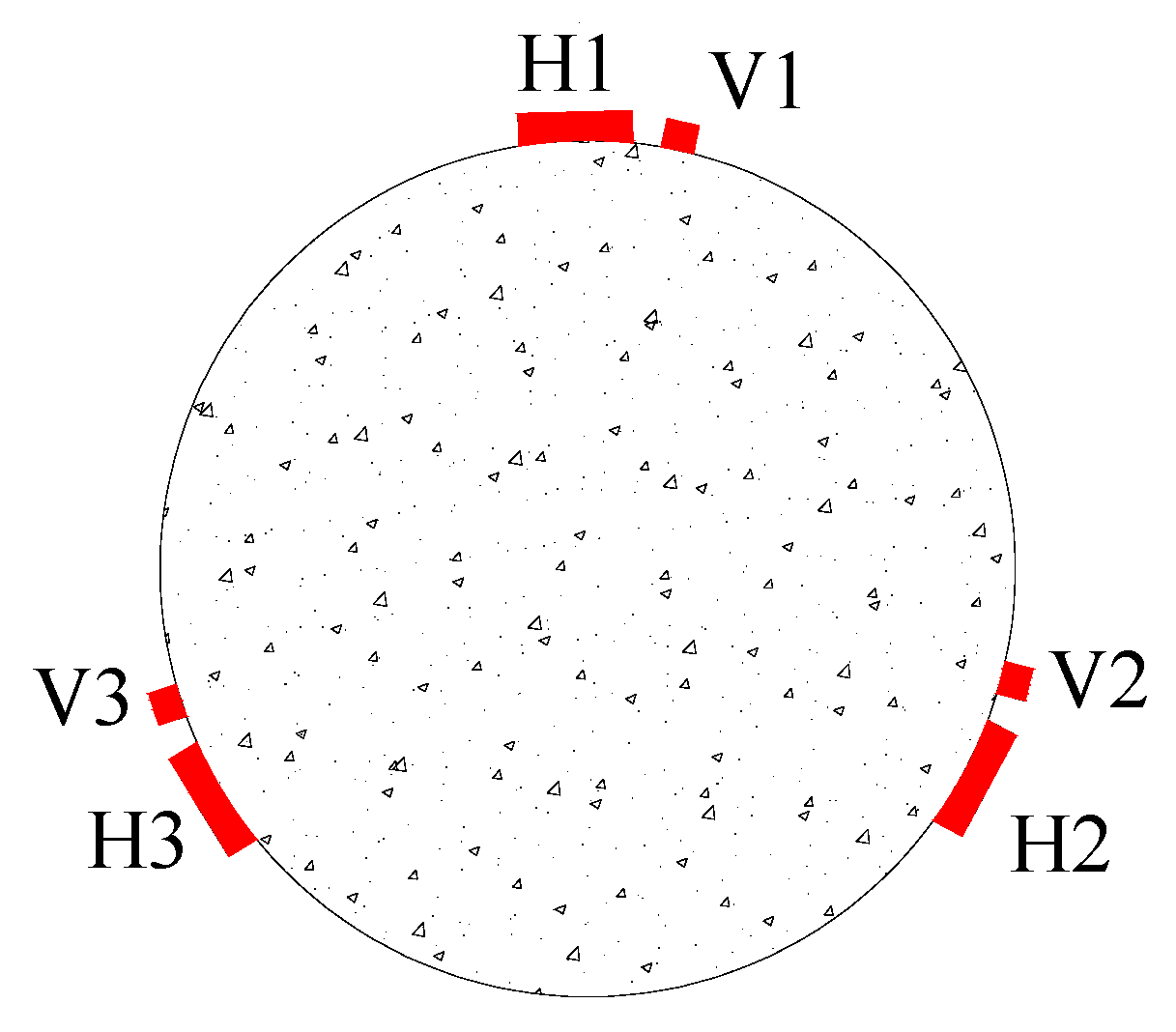

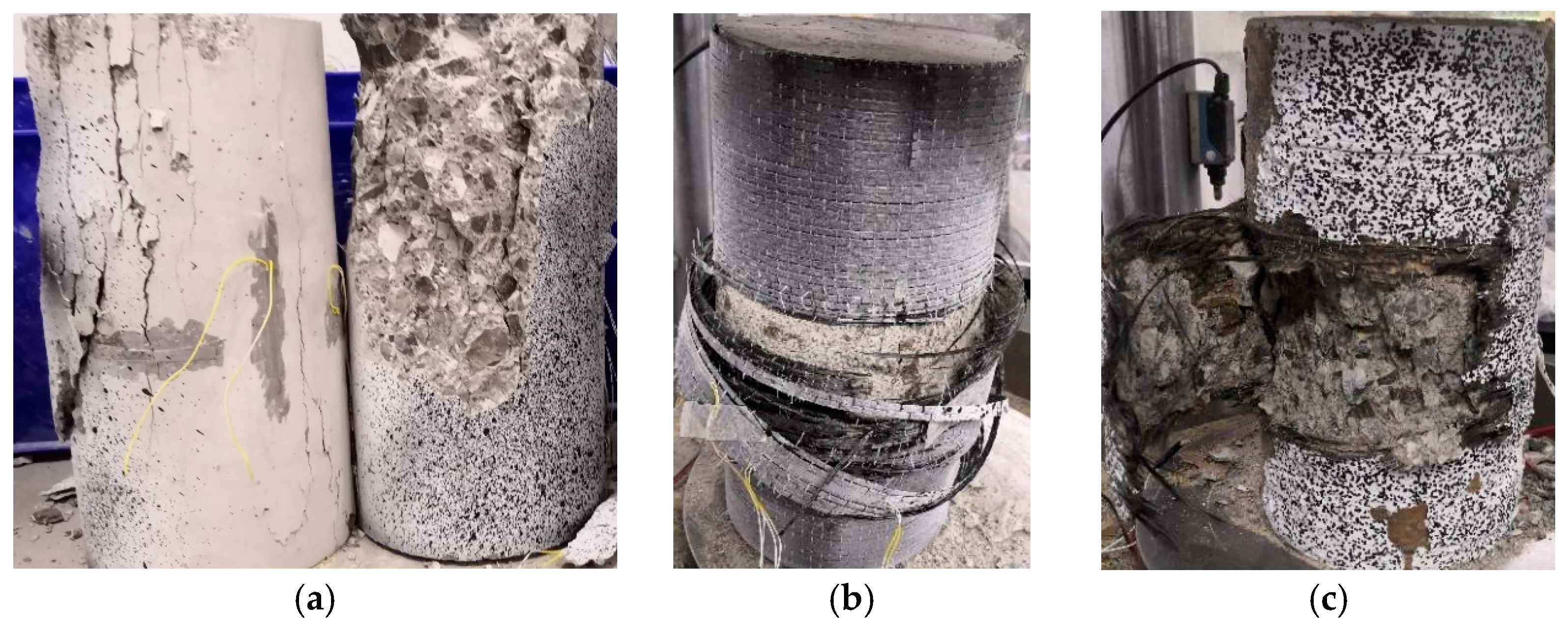

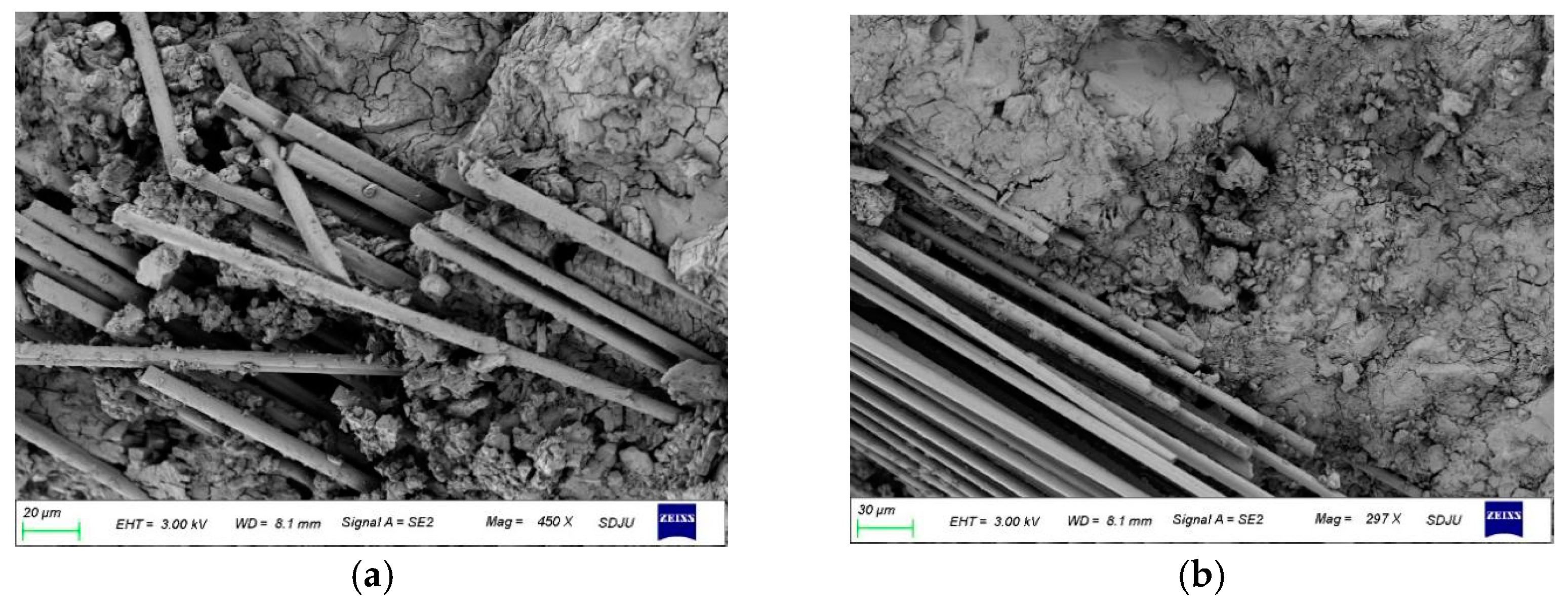
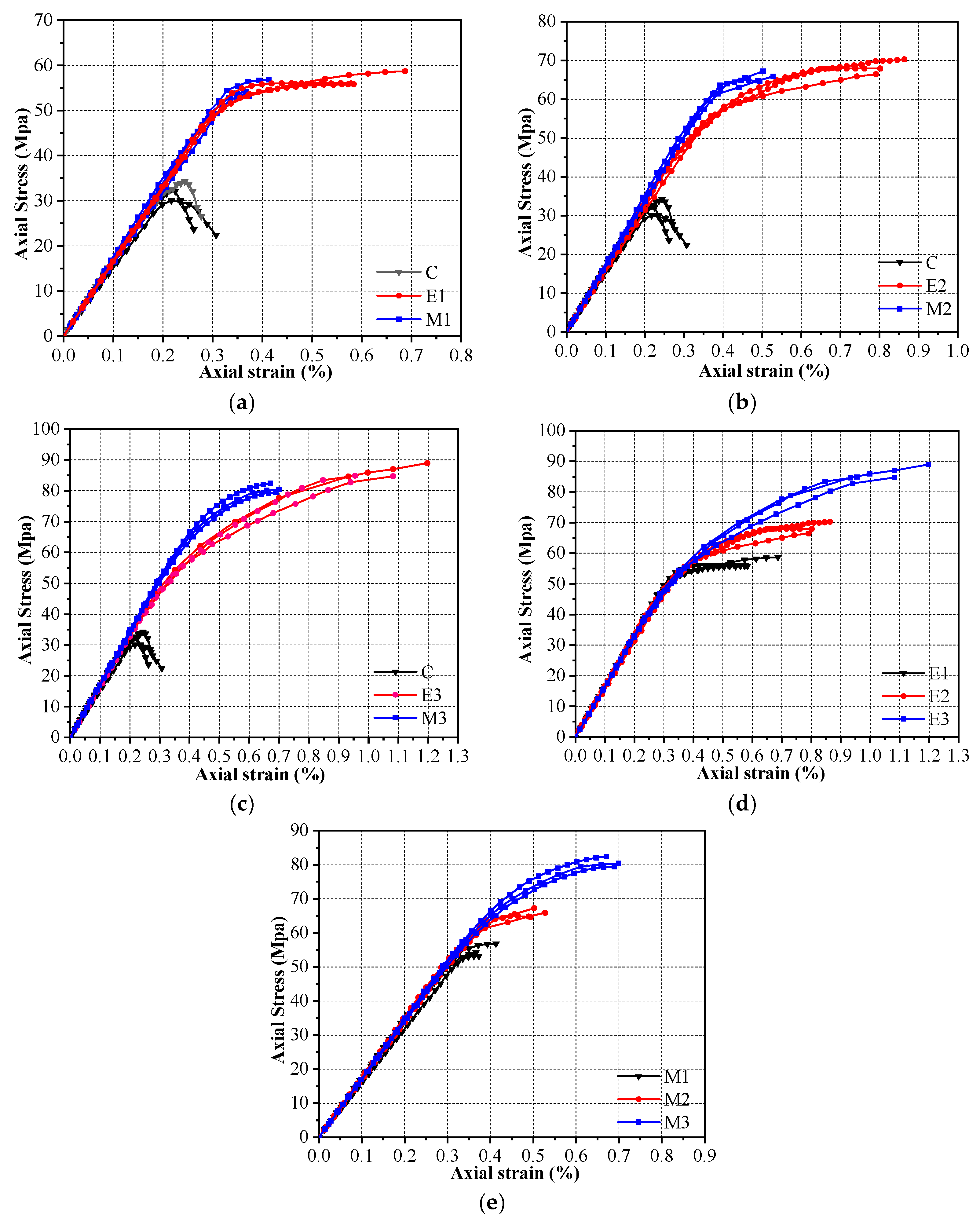
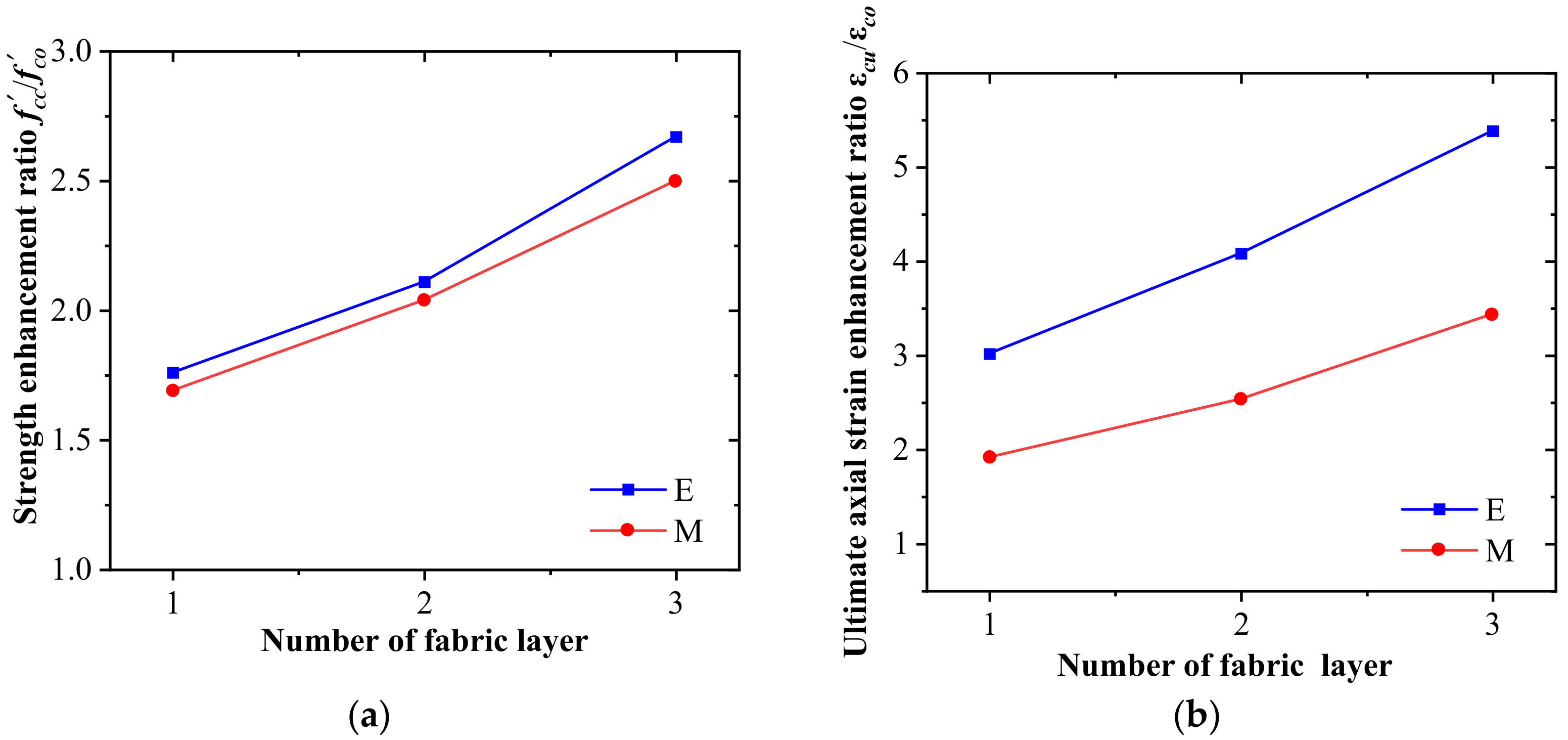
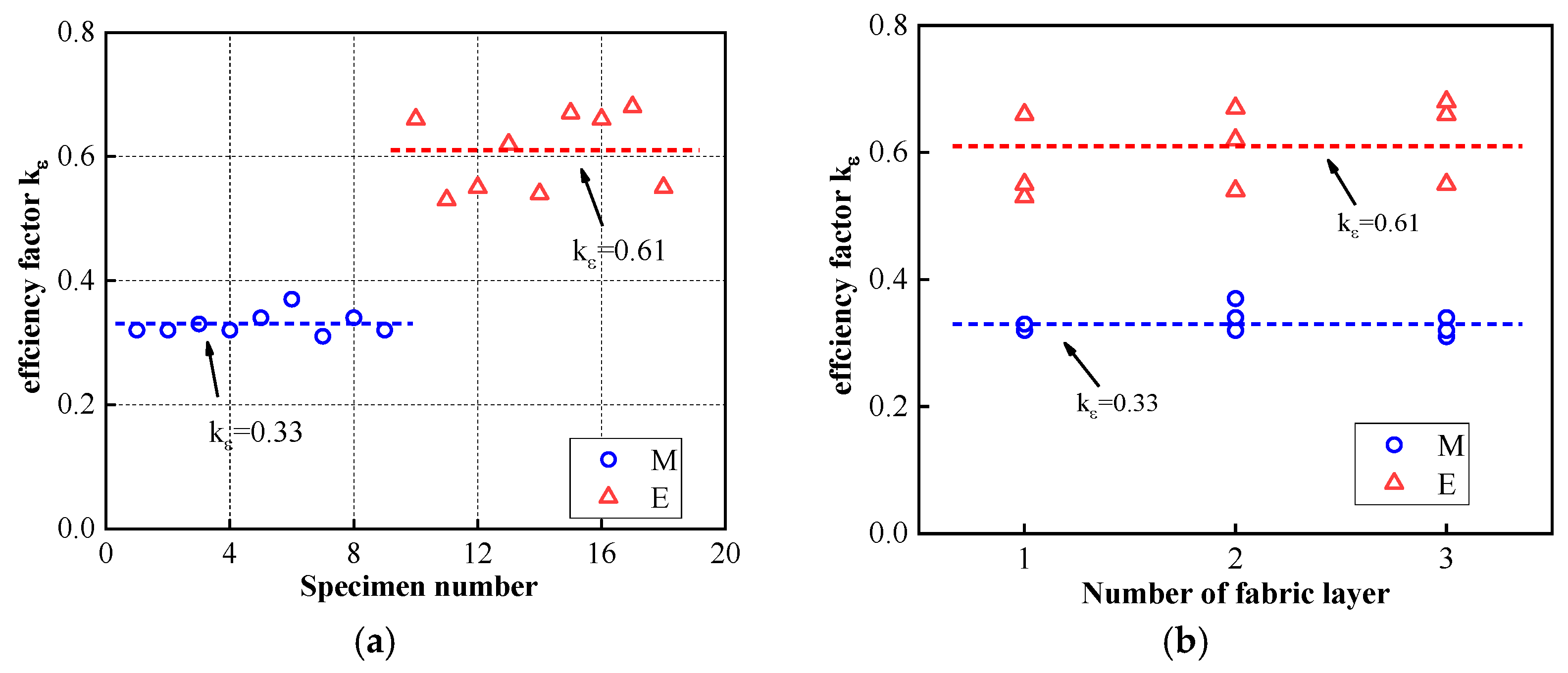
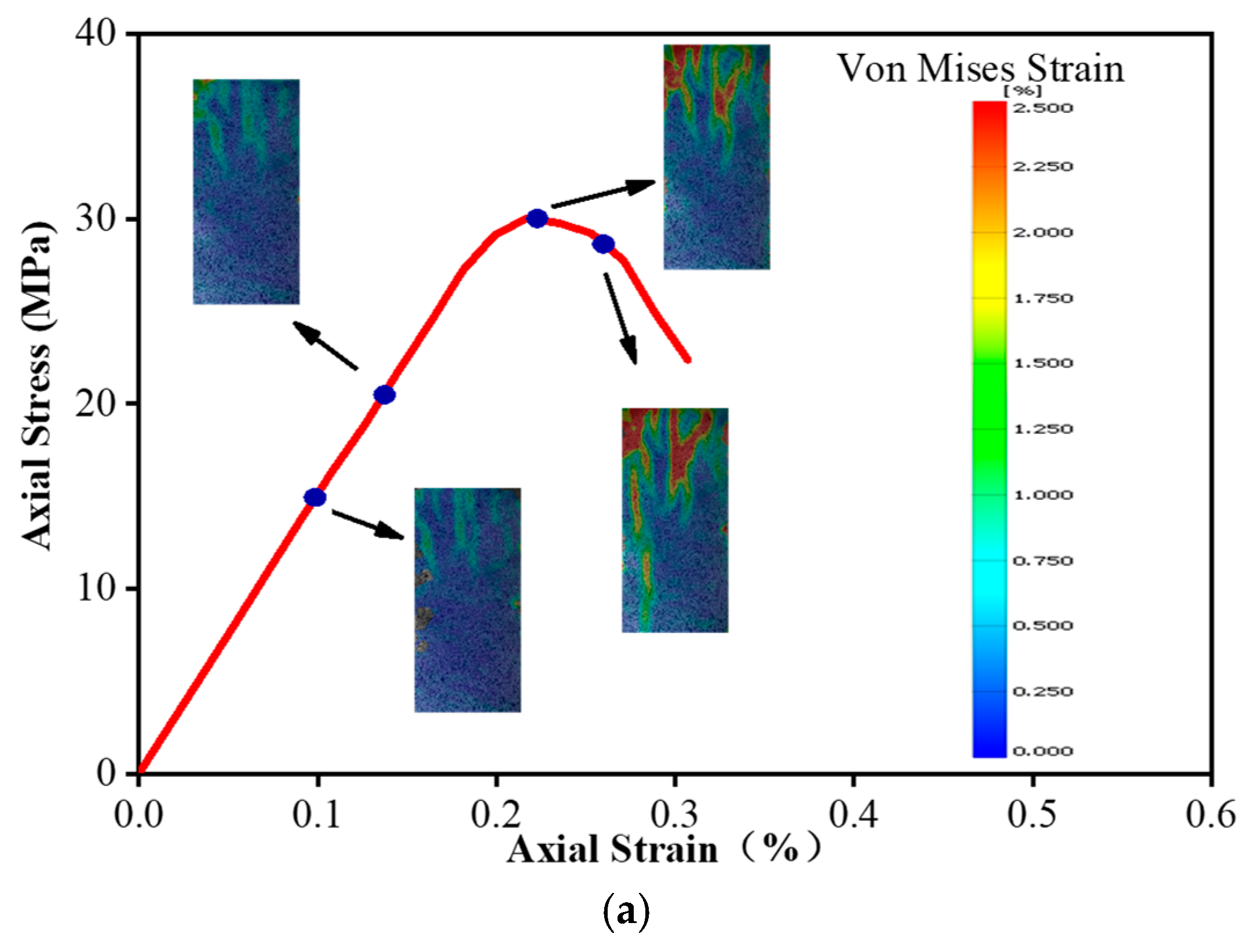
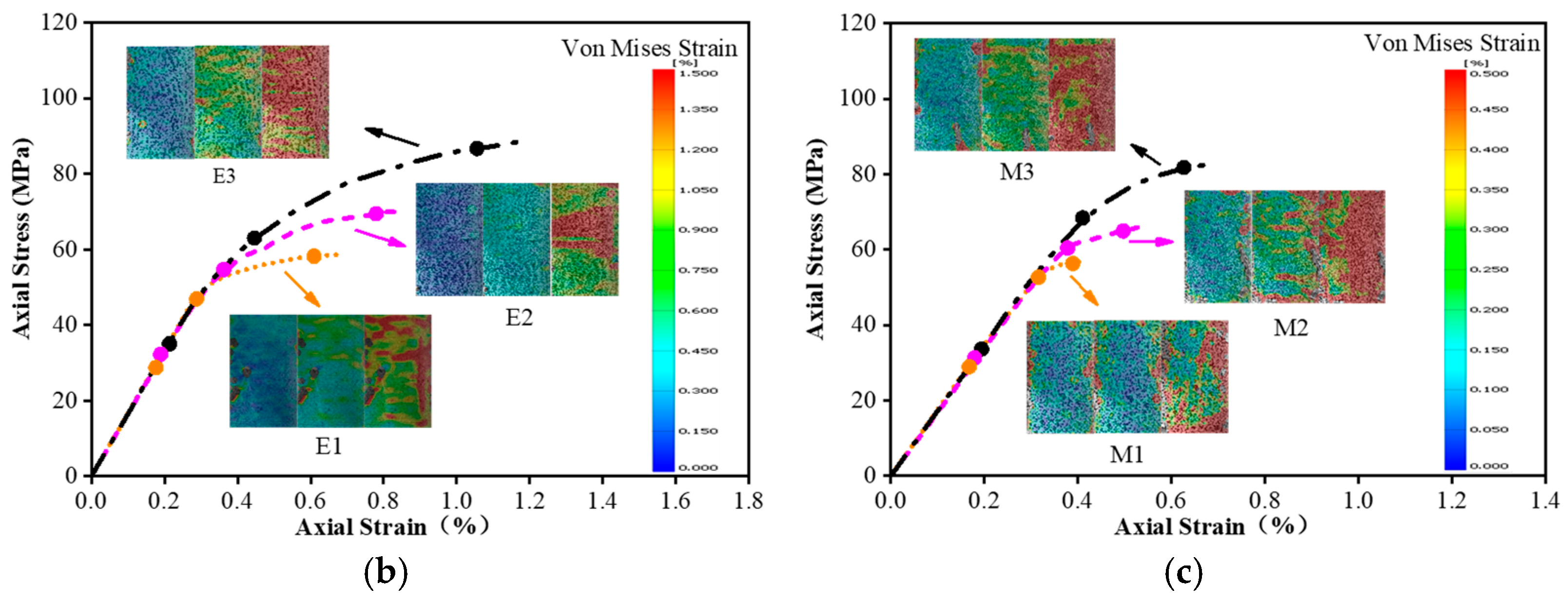
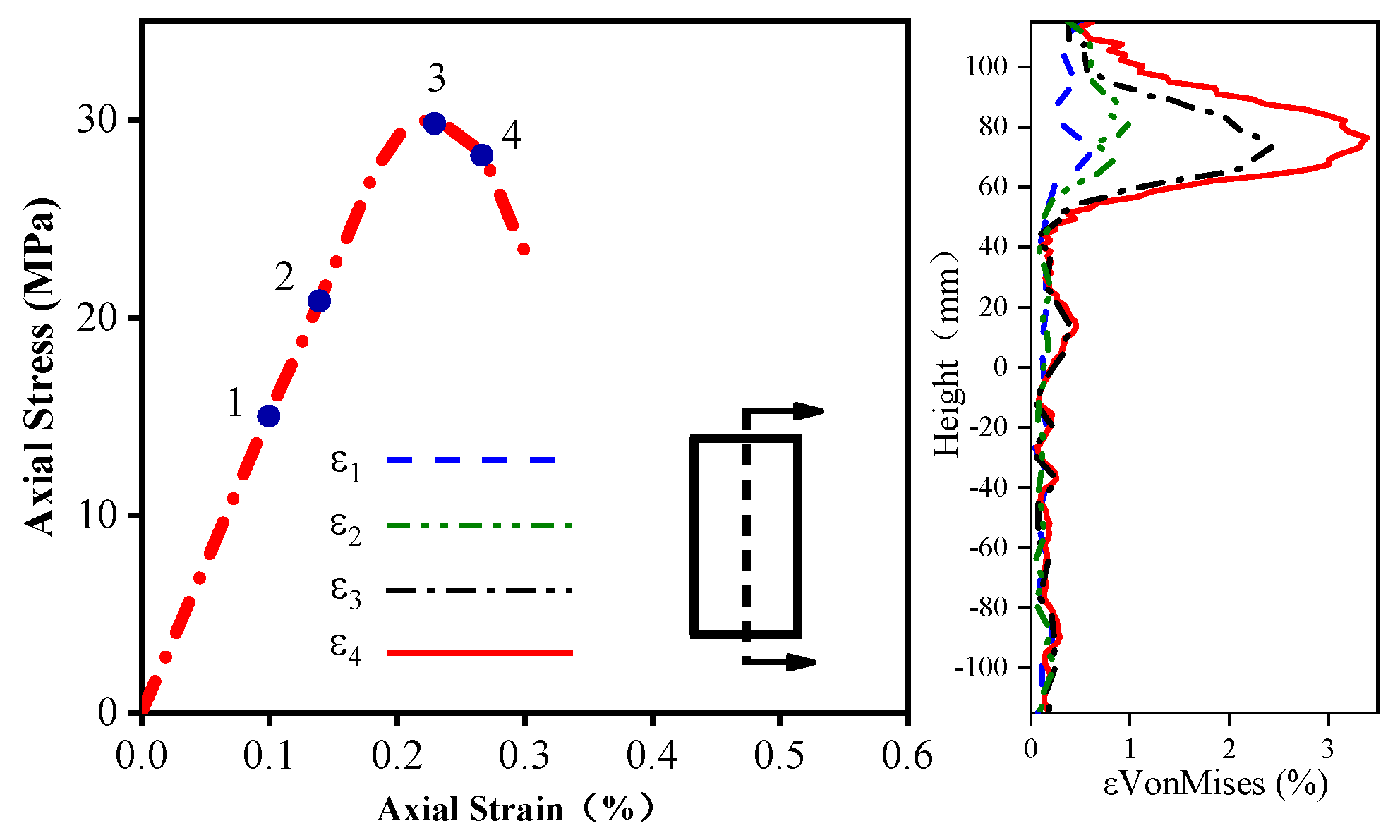
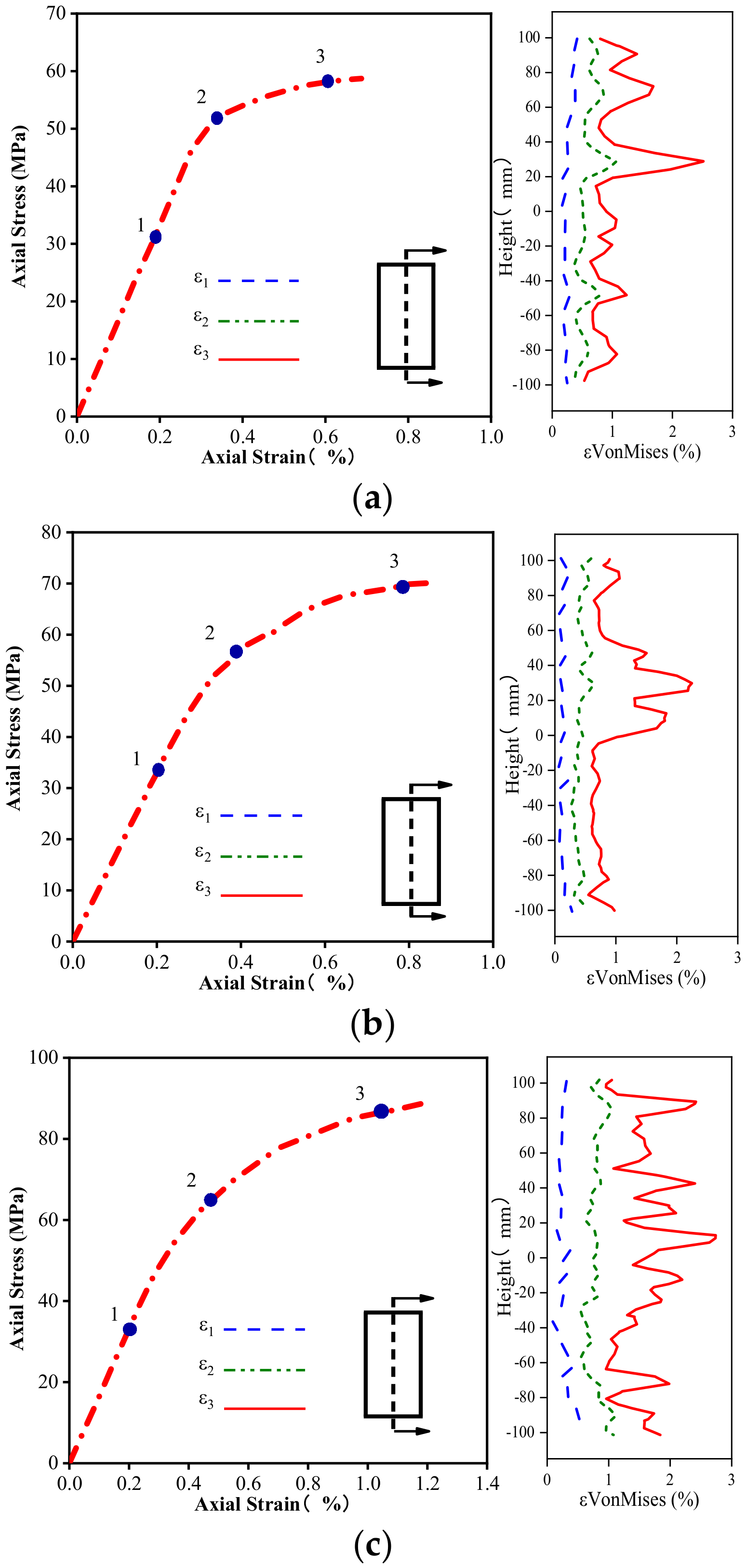
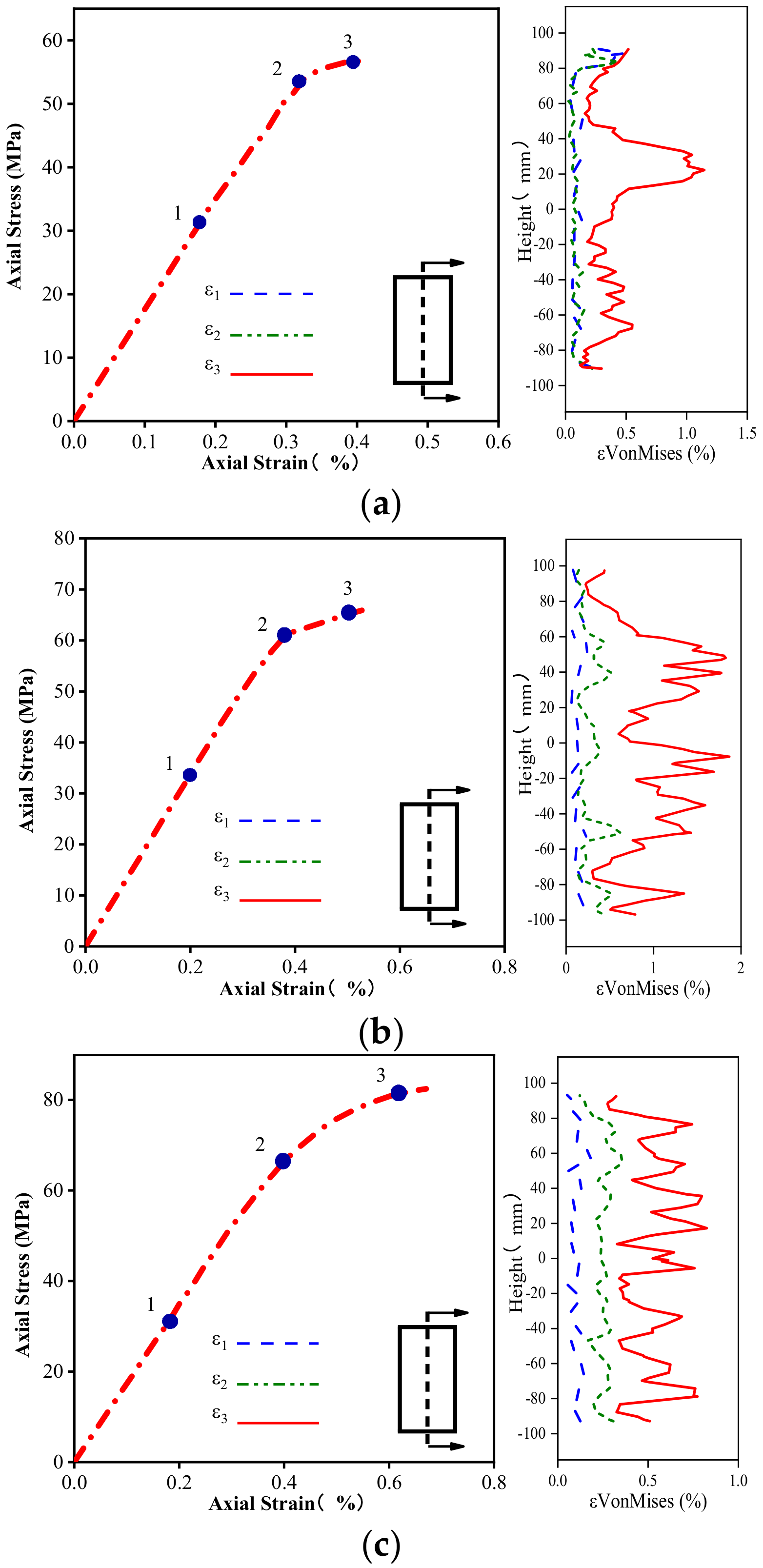
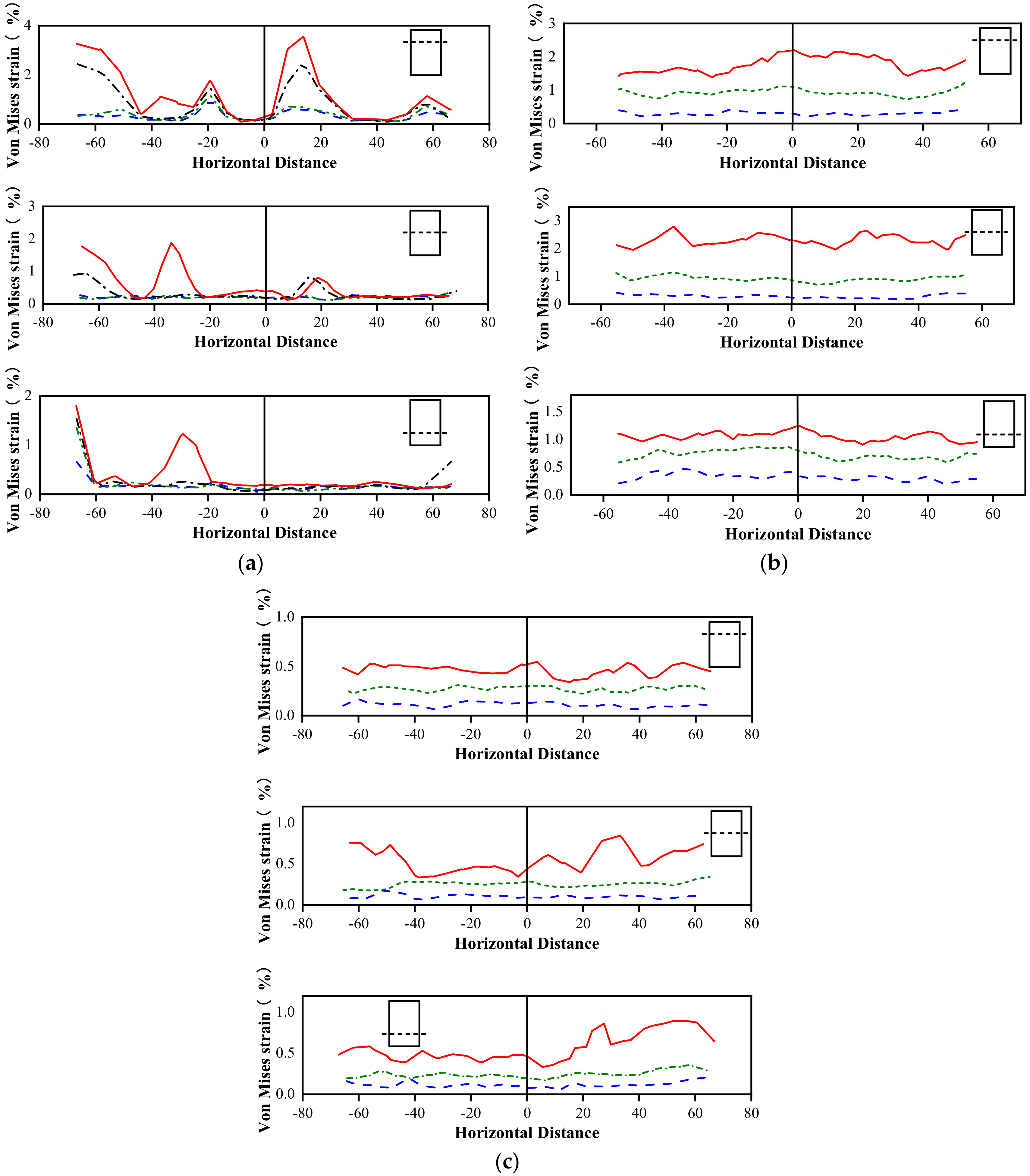
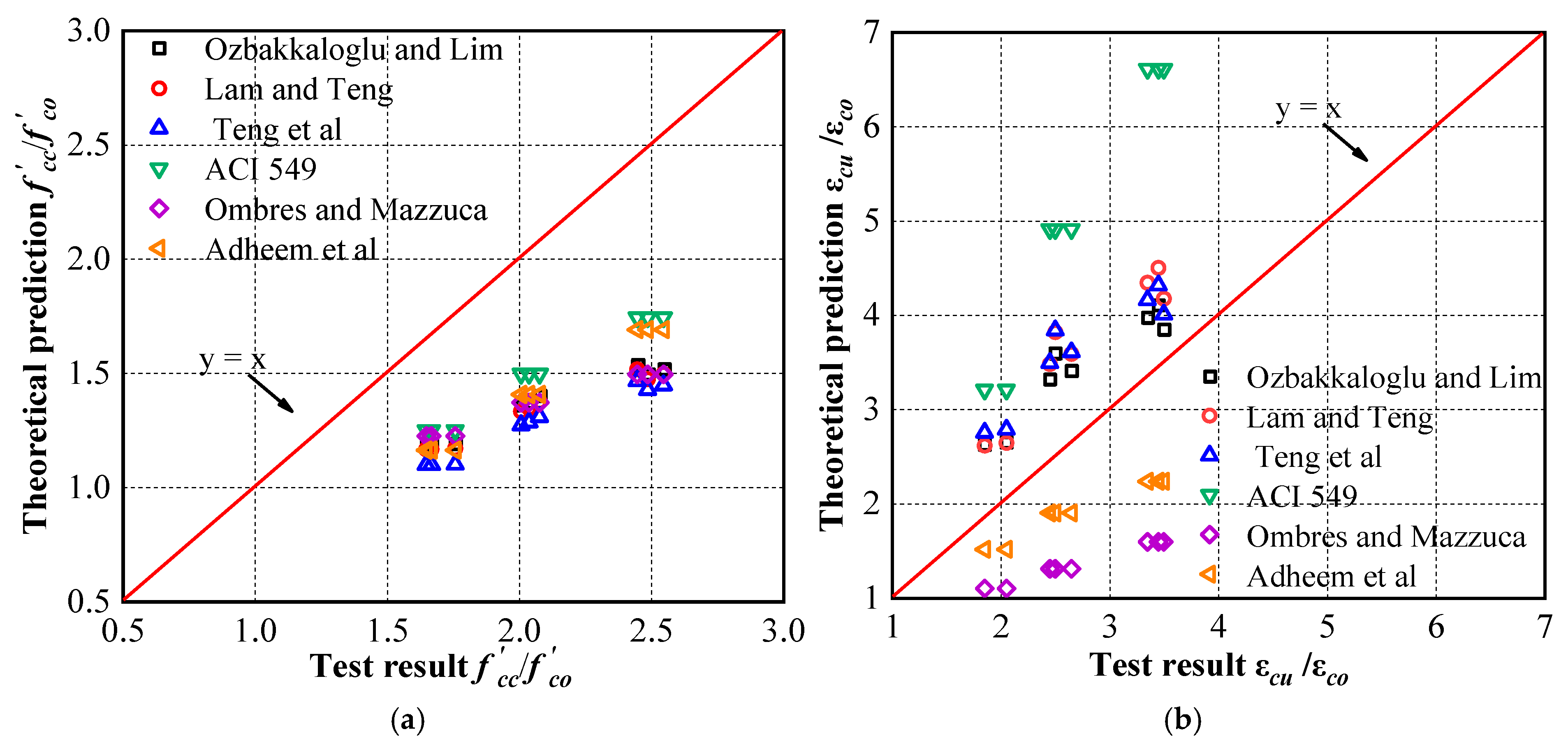

| Oxide Species | MgO | SiO2 | CaO | Fe2O3 | Al2O3 |
|---|---|---|---|---|---|
| Content (%) | 94.81 | 1.83 | 1.83 | 1.06 | 0.47 |
| Specimen Type | Specimen Group Name | FRP-Type | Number of Fabric Layers | Number of Samples |
|---|---|---|---|---|
| Unconfined | C | - | - | 3 |
| FRP-Confined | E1 | CFRP | 1 | 3 |
| FRP-Confined | E2 | CFRP | 2 | 3 |
| FRP-Confined | E3 | CFRP | 3 | 3 |
| FRP-Confined | M1 | CFRiP | 1 | 3 |
| FRP-Confined | M2 | CFRiP | 2 | 3 |
| FRP-Confined | M3 | CFRiP | 3 | 3 |
| Binder Type | Fiber/FRP Properties | ||
|---|---|---|---|
| Ultimate tensile stress, ff (MPa) | Ultimate tensile strain, εf (%) | Elastic modulus, Ef (GPa) | |
| Epoxy | 3365 | 1.39 | 242 |
| MPC | 1707 | 0.72 | 237 |
| - | 1262 | 0.55 | 229 |
| Specimen | (MPa) | (MPa) | εcu (%) | εcu/εco | εh,rup (%) | kε | |
|---|---|---|---|---|---|---|---|
| E1-1 | 32.31 | 58.70 | 0.65 | 1.82 | 3.25 | 0.92 | 0.66 |
| E1-2 | 55.85 | 0.58 | 1.73 | 2.90 | 0.74 | 0.53 | |
| E1-3 | 56.04 | 0.58 | 1.73 | 2.90 | 0.77 | 0.55 | |
| E2-1 | 66.49 | 0.79 | 2.06 | 3.95 | 0.86 | 0.62 | |
| E2-2 | 67.92 | 0.80 | 2.10 | 4.00 | 0.75 | 0.54 | |
| E2-3 | 70.30 | 0.86 | 2.18 | 4.30 | 0.93 | 0.67 | |
| E3-1 | 88.95 | 1.20 | 2.75 | 6.00 | 0.92 | 0.66 | |
| E3-2 | 84.91 | 1.08 | 2.63 | 5.40 | 0.95 | 0.68 | |
| E3-3 | 84.90 | 0.95 | 2.63 | 4.75 | 0.77 | 0.55 | |
| M1-1 | 53.17 | 0.37 | 1.65 | 1.85 | 0.45 | 0.32 | |
| M1-2 | 54.02 | 0.37 | 1.67 | 1.85 | 0.45 | 0.32 | |
| M1-3 | 56.82 | 0.41 | 1.76 | 2.05 | 0.46 | 0.33 | |
| M2-1 | 65.04 | 0.49 | 2.01 | 2.45 | 0.45 | 0.32 | |
| M2-2 | 65.89 | 0.53 | 2.04 | 2.65 | 0.47 | 0.34 | |
| M2-3 | 67.23 | 0.50 | 2.08 | 2.50 | 0.51 | 0.37 | |
| M3-1 | 80.41 | 0.70 | 2.49 | 3.50 | 0.43 | 0.31 | |
| M3-2 | 79.26 | 0.69 | 2.45 | 3.45 | 0.47 | 0.34 | |
| M3-3 | 82.44 | 0.67 | 2.55 | 3.35 | 0.45 | 0.32 |
| Ultimate Axial Stresses | Ultimate Axial Strains | |||||
|---|---|---|---|---|---|---|
| AAE | MSE | SD | AAE | MSE | SD | |
| Ozbakkaloglu and Lim | 0.34 | 0.55 | 0.04 | 0.30 | 0.56 | 0.11 |
| Lam and Teng | 0.35 | 0.59 | 0.04 | 0.36 | 0.86 | 0.09 |
| Teng et al. | 0.38 | 0.67 | 0.03 | 0.37 | 0.85 | 0.12 |
| ACI 549 | 0.13 | 0.07 | 0.03 | 0.94 | 5.21 | 0.39 |
| Ombres and Mazzuca | 0.33 | 0.56 | 0.05 | 0.48 | 1.87 | 0.05 |
| Adheem et al. | 0.32 | 0.45 | 0.01 | 0.27 | 0.68 | 0.06 |
| Proposed model | 0.02 | 0.003 | 0.03 | 0.04 | 0.01 | 0.04 |
Disclaimer/Publisher’s Note: The statements, opinions and data contained in all publications are solely those of the individual author(s) and contributor(s) and not of MDPI and/or the editor(s). MDPI and/or the editor(s) disclaim responsibility for any injury to people or property resulting from any ideas, methods, instructions or products referred to in the content. |
© 2023 by the authors. Licensee MDPI, Basel, Switzerland. This article is an open access article distributed under the terms and conditions of the Creative Commons Attribution (CC BY) license (https://creativecommons.org/licenses/by/4.0/).
Share and Cite
Zhang, Q.; Zhang, X.; Liu, Q. Compression Behavior of Concrete Columns Strengthened with Fiber-Reinforced Inorganic Composites Based on Magnesium Phosphate Cement. Materials 2023, 16, 1258. https://doi.org/10.3390/ma16031258
Zhang Q, Zhang X, Liu Q. Compression Behavior of Concrete Columns Strengthened with Fiber-Reinforced Inorganic Composites Based on Magnesium Phosphate Cement. Materials. 2023; 16(3):1258. https://doi.org/10.3390/ma16031258
Chicago/Turabian StyleZhang, Qihang, Xin Zhang, and Qiaoling Liu. 2023. "Compression Behavior of Concrete Columns Strengthened with Fiber-Reinforced Inorganic Composites Based on Magnesium Phosphate Cement" Materials 16, no. 3: 1258. https://doi.org/10.3390/ma16031258
APA StyleZhang, Q., Zhang, X., & Liu, Q. (2023). Compression Behavior of Concrete Columns Strengthened with Fiber-Reinforced Inorganic Composites Based on Magnesium Phosphate Cement. Materials, 16(3), 1258. https://doi.org/10.3390/ma16031258





